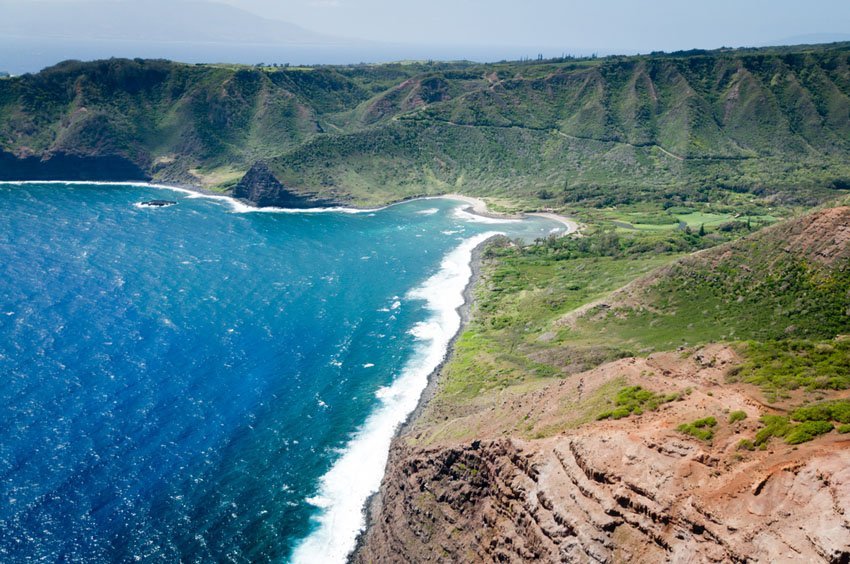Halawa Valley

Halawa Valley is one of Molokai's most scenic and culturally rich destinations. Nestled at the island's eastern tip, this lush valley features majestic waterfalls, ancient Hawaiian history, and panoramic views of Halawa Bay. Accessible via Highway 450, the valley offers hiking, beach access, and insights into Molokai's earliest settlements.
Halawa Valley, Molokai
Located on the east shore of Molokai, Halawa Valley is one of the island's top recreational areas. It has everything you may ever want in a travel spot: lush mountains, waterfalls and a nice beach park with two scenic coves.
Halawa Valley also has a rich history. It was first settled by people from the Marquesas Islands in the 7th century. For many years, this area was extensively cultivated with taro due to its fertile soil. Also, many heiaus (places of worship) were built here. Young men who dreamed of becoming kahunas (priests) came from the neighbor islands and went to the valley to learn and practice sacred spells.
The taro-growing in Halawa Valley ended after the area was hit by two tsunamis, one in 1946 and one in 1957, which covered the valley with plant-destroying salt. Today, only a few families still live in the valley and the area is mainly used for recreational purposes, such as camping, hiking, fishing, swimming and surfing.
Two of the main attractions in Halawa Valley are the 250-foot (76 m) Moa'ula Falls and the 500-foot (152 m) Hipuapua Falls. Both waterfalls can be seen from the lookout above Halawa Valley. Moa'ula can be accessed more easily, so it's more popular. However, both waterfalls are located on private property, so you will need to get permission from the land owners to reach the falls or come with a local guide who has a permit. Contact one of the tour operators on Molokai for hiking tour info.
Legend has it that a big lizard, a mo‘o, lives in the pool at the base of the waterfall. Visitors who wish to swim in it must first drop a ti leaf on the surface of the water. If it floats, it is ok and safe to swim here. If it sinks, the mo‘o is not happy and doesn't want you to enter the water.
Although Halawa Valley is as close to nature as you can get, life's most comfortable amenities are still available: from restrooms and barbecue grills to a picnic pavilion.
To get to Halawa Valley, drive Highway 450 east all the way to its end. The valley is located about 30 miles (48 km) from Kaunakakai.
Key Features of Halawa Valley
- Historic site: First settled in the 7th century by Polynesians from the Marquesas Islands.
- Two famous waterfalls: Moa'ula Falls (250 ft) and Hipuapua Falls (500 ft), both viewable from the lookout.
- Guided access only: Waterfalls are on private land - guided tours or landowner permission required.
- Scenic beach park: Halawa Beach Park features two coves for swimming, surfing, and picnicking.
- Rich cultural legends: Local mo'o (lizard) folklore and remnants of heiau (temples) add depth to the valley's experience.
Frequently Asked Questions
Can I visit the waterfalls in Halawa Valley?
Yes, but they are located on private property, so you'll need to join a guided tour or obtain permission from the landowners.
Is camping allowed in Halawa Valley?
Certain areas allow camping, but it's recommended to check with local authorities or tour operators before setting up camp.
How do I get to Halawa Valley?
Drive east on Highway 450 from Kaunakakai all the way to its end. The valley is located about 30 miles (48 km) from town.
Why is Halawa Valley historically significant?
It was an early Polynesian settlement and home to sacred sites, taro cultivation, and kahuna training grounds.
What's the legend about the mo'o at the waterfall?
Legend says a mo'o (guardian lizard) lives at the base of Moa'ula Falls. Drop a ti leaf into the water - if it floats, you may swim; if it sinks, the mo'o doesn't welcome you.

















